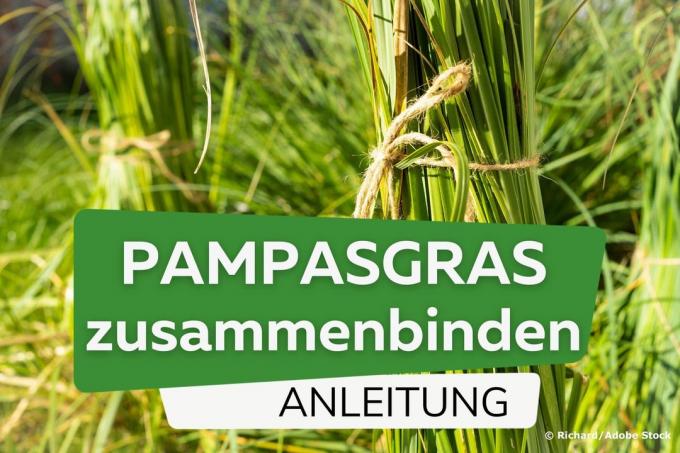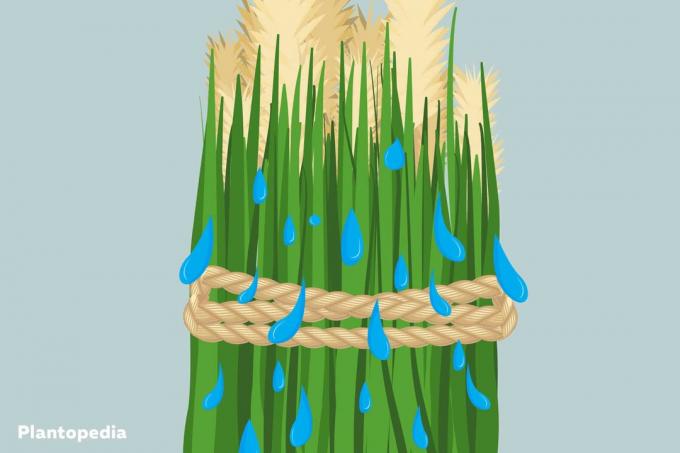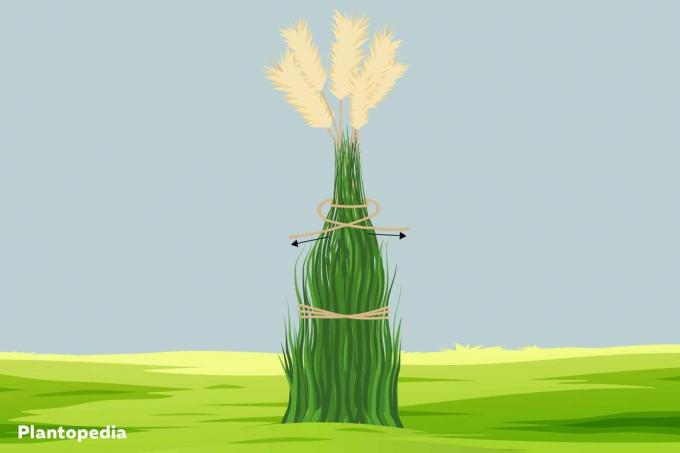
For a correct and safe wintering you should tie up pampas grass in the fall. Interested hobby gardeners can find out here how easy it is to do this and how you can easily undo the binding again in the spring.
In a nutshell
- tied tuft as protection against wet and cold
- Brushwood as additional insulation
- Carry out the measure before the first frost
- Only start cuttings in late spring
- adapted hibernation in buckets
Table of contents
- Why tie pampas grass together
- Step-by-step instructions
- Additional protection
- tub culture
- time
- frequently asked Questions
Why tie pampas grass together
The name of the pampas grass already gives an idea of its origin: the pampas. In terms of temperature, the winter climate does not differ significantly from that in Germany. Frost is tolerated at depths of up to -17 degrees Celsius. The situation is different with regard to humidity and precipitation. While the winters are dry in the pampas, they are associated with high humidity and a lot of precipitation in the form of rain and snow in the local regions. This means two risks for the pampas grass.
On the one hand, rot can occur when water accumulates between the individual stalks or in the eyrie. On the other hand, frost can cause explosions. Just as with stone or asphalt, for example, moisture penetrates and expands when it freezes. This causes damage to the plant because the cells are burst open from the inside.

So the problem is not the sub-zero temperatures, but the combination with liquid. Tying it together turns the tuft into a kind of umbrella, because rain and snow can no longer penetrate the interior in large quantities. Instead, they run off to the side.
Step-by-step instructions
Pampas grass can be easily tied together in the fall if the appropriate preparations have already been made.
Materials needed:
- helpers if necessary
- Gloves
- safety goggles
- Scissors
- cord or rope
If these are ready, the actually simple work can begin.
- Embrace the forelock from below: The tying begins near the ground. Otherwise, shorter stems will stick out and create weak points. The gloves already prove their worth here, because the blades have sharp edges and can cause cuts and inflammation as a result.
- Make the first tying: With a strong cord or rope, the stalks are tied together by applying pressure from the outside and tightening. The thread should be wrapped around the tuft of hair several times and knotted tight, because there is a considerable amount of tension on the material, especially on the bottom line.
- Shorten the string: Excessive lengths of thread are cut off or knotted together as far as possible. If they protrude to the ground, the material can decompose more quickly.
- Repeat process: Depending on height of the pampas grass several bindings are now set at intervals that become smaller towards the top. The upper end must be tied into a tight point, otherwise the measure will not serve the intended purpose.

Tip: It makes sense to carry out the task in pairs, not only with very extensive variants. While one holds the straws tightly and tightly together, the second can more safely and easily wrap the cord around them.
Additional protection
Water is not only a risk when it hits the eyrie from above or gets caught between the stalks. Wet soil can also be a problem. In addition to tying it up, the ground around the pampas grass should be covered with leaf or needle sticks. This creates a protection that prevents damage and promotes stronger budding in the spring.
tub culture
Pampas grass cultivated in tubs can be set up in such a way that it is protected from frost from below and the planter is protected from the side and no precipitation can fall on it from above. That doesn't mean, however, that the hair can remain open. Humidity alone is enough to pose a risk.

It is therefore ideal:
- to set up the planter in a protected and covered way
- to tie the tuft together
- underlay styrofoam
- Wrap the pot in fleece or jute
In this way, complete freezing is avoided.
Tip: Overwintering in the house is also possible. However, the pampas grass should be light even then.
time
You should tie up the pampas grass on a dry day in the fall before the first frost. In damp weather, liquid may have already penetrated and must first dry off. Although temperatures in Germany are often only expected to fall below zero in November, early to mid-October are still more advisable times.
frequently asked Questions
Ambitious hobby gardeners can artfully braid pampas grass. However, braiding does not always ensure that rain runs off to the side.
The cords from tying the tuft can either be loosened or the ones that have dried up in the meantime Cut the culms directly tied together when frost is no longer to be expected in late spring is. This involves cutting close to the ground to remove as much old plant material as possible.
A blend in the fall is devastating. If pruning is desired, it should not be done until late April or early May after the last frost.
This depends on the climate of the respective region. In mild temperatures it stays green. Otherwise it will dry up over time or the above-ground parts will freeze. The new sprouting takes place comparatively late. The rapid growth, however, ensures dense and fresh green in a short time.
